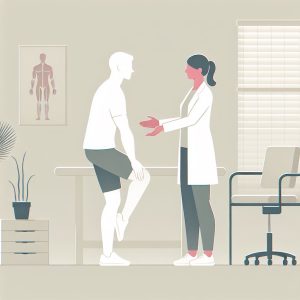Generative AI as a Professional Issue in Physiotherapy – “It ain’t what you prompt, it’s the way that you prompt it!”

Institution: Trinity College Dublin
Discipline: Physiotherapy
Author: Cuisle Forde
GenAI tool(s) used: Kemtai
Situation / Context
The role of artificial intelligence in physiotherapy is varied and evolving (Rowe et al., 2022; Simeoni et al., 2021). As an administrative tool, it can be used to help with patient scheduling and as a treatment tool it has been used to monitor exercise (Moscato et al., 2023), correct movements (Francisco and Rodrigues, 2023), individualise resistance to movement and help with clinical reasoning (Wong et al., 2023; Hasan et al., 2023). It is clear that the use of AI is relevant in Physiotherapy and has the potential to help with many challenging tasks physiotherapists encounter on a daily basis. With a view towards tasking students to critically appraise the use of generative AI in their profession, in the academic year 2023/24 we added AI as a topic to our module entitled “Professional issues”. As this topic was not previously taught, two years of students were grouped together for a class on this topic. The timetable afforded us one hour of asynchronous online teaching and one hour of live-in-class teaching, but this will likely be increased for future cohorts. There were approximately 75 students in total in the class.
Task / Goal
The aim of the session was to facilitate an open discussion about the opportunities and limitations of GenAI relevant to Physiotherapists.
Learning outcomes were to:
- identify opportunities that GenAI tools present generally and in the clinical setting;
- discuss the potential for bias, inaccuracy, misinformation, and ethical issues.
This was the first year we were integrating this topic into the module, so it has not yet been aligned with assessments, and the LOs were deliberately “low” on Bloom’s hierarchy. During the summer months, the curriculum will be reviewed, and greater clarity will likely emerge regarding the LOs related to this topic within the module.
This topic was added as we are aware that GenAI is used in clinical practice and is increasingly relevant to the clinical professions, including Physiotherapy. We feel that as educators we need to equip our students with the best chance to enhance patient care, and AI is now part of that! Furthermore, as with any skill, using Generative AI effectively requires specific knowledge and practice- something which was not previously covered in our course.
Actions / Implementation
Students were asked to perform a SWOT analysis before the class (asynchronous online activity) outlining the opportunities, risks, strengths, and weaknesses of AI for the profession of Physiotherapy. This task resulted in many interesting observations and insights. One common theme mentioned was the opportunity presented by GenAI to aid clinical reasoning and differential diagnosis. It is worth noting that clinical reasoning and differential diagnosis are difficult high-level skills required of students. It is, therefore, unsurprising that students would be thankful for support from something like a GenAI platform to tackle such tasks.
On this basis, during the live class, a well-known GenAI platform was asked to “propose possible Physiotherapy diagnosis” for a complex case study. The case study chosen by the academic included covert red flags (i.e. serious issues that should never be missed in a clinical setting) and resulted, by design, in a contentious issue arising around the ability of the Gen AI platform to appreciate and understand the professional remit of a Physiotherapist – which was subsequently debated in class.
Specifically, the issue was around the fact that when the GenAI platform was asked to propose a diagnosis for a Physiotherapist, the potential presence of serious pathology was not mentioned, however, if the word Physiotherapist was omitted from the response, the platform immediately alerted the reader to the potential presence of a life-threatening pathology. Continuing the conversation with the software platform, we asked why this information was omitted when being asked by a Physiotherapist. The response was that it was not within a Physiotherapists professional remit to diagnose such diseases. While this is true, it is certainly within our professional remit to refer our patients to other professionals and to ensure we work in the best interest of our patients, neither of which would have happened if we had relied only on the initially generated answer. The most interesting part of this exercise was arguably the difference in response when the prompt was altered by one word emphasizing the importance of wielding GenAI with care. This case study proved to showcase both the potential of AI to be a help and its bias and potential to negatively impact on treatment/care.
Moving on from the case study, we discussed academic integrity and outlined the impact of plagiarism through GenAI use at third level on the wider profession of Physiotherapy. We asked students to contribute to the solution for this issue especially when it comes to take-home assignments – interesting and wide-ranging comments and opinions were shared on this topic.
We then began to move – literally. Students tried a GenAI exercise program (see resources below), which corrects movements in real-time and provides feedback to the person exercising as well as to the therapist prescribing the exercise. Students used live polling throughout this session and when asked if they could see a use for a program such as the Gen AI exercise program in their clinical practice, they agreed that they could.
We ended the live class by discussing whether, as a profession, we should contribute to the content that GenAI uses, and if so, how. We questioned if it was possible for us to alter algorithms and questioned who or what was really leading to the outcomes produced. That is unfortunately all we managed to cover in an hour but as part of the SWOT analysis conducted prior to class students proposed many ways with which we could incorporate AI into our curriculum, such as asking an AI bot to pretend to be a patient and then have a conversation with that patient (the transcript of this conversation could then be assessed by the academic).
Outcomes
There was no summative evaluation of the session, but live poll contributions, online discussion board posts, and live class contributions indicated a high level of engagement. Some students reached quite an impressive depth of thinking/consideration, while others enjoyed the lighter side of the topic!
Reflections
I learnt that students can and will tell us how to integrate AI into the curriculum and what they need to know if we simply ask them the correct questions. Next year, I will dedicate more time to this topic, and we will be able to teach one year group at a time (as this will not be the first year of this topic being introduced). Smaller numbers will also help facilitate better in-class debates and discussions.
Digital Resources
https://kemtai.com/—When I asked, the company agreed to give me a trial version of this software so that I could share it with students. That worked really well!
Author Biography
Dr Cuisle Forde is an Assistant Professor in the Discipline of Physiotherapy, at Trinity College Dublin. She graduated with a BSc in Physiotherapy from Trinity College Dublin in 2008. Having been awarded a Trinity scholarship during her undergraduate career, and an Irish Research Council scholarship to conduct a PhD, she began work on her doctoral thesis the following autumn, which she completed in 2012. During her doctoral studies, Cuisle investigated the efficacy of active video games as a form of exercise for children who have cystic fibrosis and those attending weight management clinics. She also examined the capability of an active video game to be used as a tool to estimate cardiorespiratory fitness. She completed a Diploma in Statistics and was also involved in research projects investigating arterial stiffness and physical activity in adults. After spending some time working clinically and lecturing in critical thinking in Kosovo, Cuisle returned to Dublin in September 2013 to begin a postdoctoral research fellowship in the Discipline of Physiotherapy, at Trinity College Dublin. With an interest in technology and innovative teaching methods, Cuisle helped develop the Online Postgraduate Certificate and Diploma in Clinical Exercise and is now the coordinator for this course. Her latest publications investigate the efficacy of e-learning for the acquisition of clinical competencies.

